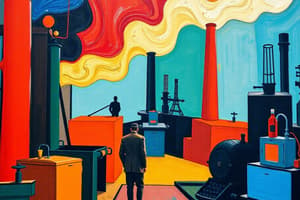Podcast
Questions and Answers
What was a major consequence of the transition from manual labor to machine-based manufacturing during the Industrial Revolution?
What was a major consequence of the transition from manual labor to machine-based manufacturing during the Industrial Revolution?
- A reduction in new social classes
- A decrease in urbanization
- An increase in industrial centers and cities (correct)
- A decline in economic growth
Which of the following was a characteristic of the Victorian Era?
Which of the following was a characteristic of the Victorian Era?
- A decrease in British imperialism
- A focus on scientific and technological advancements (correct)
- A relaxing of moral standards
- A decline in social and economic inequality
What was a major impact of the British Empire on colonized societies?
What was a major impact of the British Empire on colonized societies?
- Cultural exchange and mutual understanding
- Economic development and resource sharing
- Cultural and social change (correct)
- The spread of democratic values
What was the significance of the Factory Acts in the fight for workers' rights?
What was the significance of the Factory Acts in the fight for workers' rights?
Who was a key figure in the fight for women's suffrage in the late 19th and early 20th centuries?
Who was a key figure in the fight for women's suffrage in the late 19th and early 20th centuries?
What was the result of the Representation of the People Act in 1918?
What was the result of the Representation of the People Act in 1918?
What was a key feature of the Industrial Revolution?
What was a key feature of the Industrial Revolution?
What was the significance of the Trade Union Act in 1871?
What was the significance of the Trade Union Act in 1871?
Flashcards are hidden until you start studying
Study Notes
Industrial Revolution
- Timeline: Late 18th to early 19th century
- Key features:
- Transition from manual labor to machine-based manufacturing
- Development of steam power and factories
- Growth of cities and industrial centers
- Increased productivity and economic growth
- Impact on society:
- Creation of new social classes (industrialists, workers)
- Urbanization and growth of cities
- Changes in family structure and women's roles
Victorian Era
- Timeline: 1837-1901 (reign of Queen Victoria)
- Characteristics:
- Social reform and morality
- Growing British Empire and imperialism
- Advances in science, technology, and art
- Increased social and economic inequality
- Notable figures:
- Queen Victoria
- Charles Dickens (author)
- Florence Nightingale (nurse and statistician)
British Empire
- Timeline: 16th century to mid-20th century
- Key features:
- Colonization and expansion of British territories worldwide
- Economic exploitation and resource extraction
- Cultural and social impact on colonized societies
- Rise of British nationalism and imperialism
- Notable events:
- Opium Wars with China
- Scramble for Africa
- Indian Rebellion of 1857
Workers' Rights
- Timeline: Late 18th to early 20th century
- Key milestones:
- Factory Acts (1802, 1833) regulating working conditions
- Trade Union Act (1871) legalizing labor unions
- formation of Labour Party (1900)
- Notable figures:
- Robert Owen (factory reformer)
- Sidney and Beatrice Webb (Fabian socialists)
Women's Suffrage
- Timeline: Late 19th to early 20th century
- Key milestones:
- Formation of women's suffrage societies (1860s)
- Property Acts (1870, 1882) granting women property rights
- Representation of the People Act (1918) granting women's suffrage
- Notable figures:
- Emmeline Pankhurst (suffragette leader)
- Christabel Pankhurst (suffragette leader)
- Millicent Fawcett (suffragist and politician)
Industrial Revolution
- Duration: Late 18th to early 19th century
- Transformative factor: Transition from manual labor to machine-based manufacturing
- Power source: Development of steam power
- Consequences:
- Growth of cities and industrial centers
- Increased productivity and economic growth
- Creation of new social classes (industrialists, workers)
- Changes in family structure and women's roles
Victorian Era
- Duration: 1837-1901 (reign of Queen Victoria)
- Social reform: Emphasis on morality and social reform
- Imperialism: Growing British Empire and expansion
- Advances:
- Science
- Technology
- Art
- Social and economic inequality: Increased gap between rich and poor
- Notable figures:
- Queen Victoria
- Charles Dickens (author)
- Florence Nightingale (nurse and statistician)
British Empire
- Duration: 16th century to mid-20th century
- Territorial expansion: Colonization and expansion of British territories worldwide
- Economic impact: Exploitation and resource extraction
- Cultural impact: Significant cultural and social impact on colonized societies
- Nationalism: Rise of British nationalism and imperialism
- Notable events:
- Opium Wars with China
- Scramble for Africa
- Indian Rebellion of 1857
Workers' Rights
- Duration: Late 18th to early 20th century
- Factory regulation: Factory Acts (1802, 1833) regulating working conditions
- Labor union legalization: Trade Union Act (1871)
- Political party formation: Labour Party (1900)
- Notable figures:
- Robert Owen (factory reformer)
- Sidney and Beatrice Webb (Fabian socialists)
Women's Suffrage
- Duration: Late 19th to early 20th century
- Suffrage society formation: Women's suffrage societies (1860s)
- Property rights: Property Acts (1870, 1882) granting women property rights
- Suffrage granting: Representation of the People Act (1918)
- Notable figures:
- Emmeline Pankhurst (suffragette leader)
- Christabel Pankhurst (suffragette leader)
- Millicent Fawcett (suffragist and politician)
Studying That Suits You
Use AI to generate personalized quizzes and flashcards to suit your learning preferences.



